Words cannot express how important stropping is. Read on to find out exactly what stropping does and why you should do it.
This article’s aim is to educate you on how to properly strop your razor. From how to grip the strop, to how to perform each stroke. We will show you the right way to strop your razor and the correct number of laps you need to do in order to keep your razor in tip top shape.
Attaching the Strop
When your stropping, you need to do two things: control the tautness of the leather and control the razor. In order to pull the strop taut, you either need a paddle strop (in which case you can skip ahead) or you need to attach the non-handle end to something. I personally prefer my doorknob attached with a piece of leather thong. As you can see from the pictures, a simple loop made with a square knot easily attaches to a metal rod.
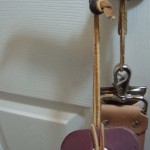
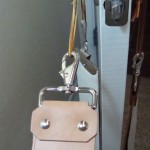
In the picture on the left, you can see a very basic strop with just a hole in the top attached using a very long loop of leather. This is by far the simplest method of attachment. To the right is how I attach my personal strops. They all have hooks so I use the same principle as show to the left, but hook onto the end of the loop. I don’t use the included metal circle and prefer this method because the flexibility of the leather thong really helps to keep the strop flat.
Holding the Strop
The oldest style of strop is just a square cut at the bottom. Also known as barber’s style. Don’t know why. There is really only one way to hold this type of strop. Using your thumb and forefinger you pinch the bottom and pull. Pictured to the right of the square cut bottom is a D-Ring. A D-Ring is just that a metal ring in the shape of a D. It is attached to the strop on the straight end and you hold the round end. You hold it as pictured with more or less fingers as desired.
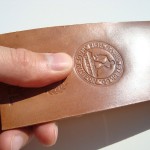
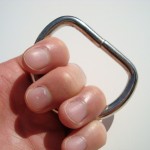
As strops evolved, the D-Ring (pictured above) and strop handles evolved (pictured below). A strop with a handle can be held either by the handle or in the same manner as a barber’s strop. If you own a Tony Miller strop or a clone, your strop will have a square ring with a leather handle. This type of strop presents infinite ways to keep the strop taut. Take a look!
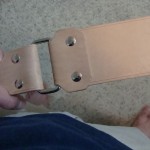
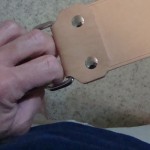
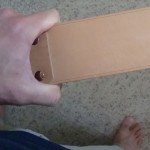
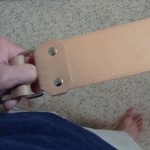
By far the most popular way to grip the strop is by the handle. It is the easiest and most intuitive way to pull the strop taut. That said, I actually prefer some of the other methods shown. I find they are a little easier to hold and keep the strop taut.
You’ll notice in the pictures that the strop is being held waist high and pulled to near the middle of my body. My feet are apart and provide a solid foundation. What is important in where you pull the strop to is that you are able to have full range of motion for your stropping hand. Too close to your body and it will get in the way on the downward stroke. Too far away and your stretching to reach the leather. Etc.
How Taut Should the Strop Be?
The tautness of the strop is also important, although there is a ton of leeway as continually demonstrated by pictures and videos of barbers using extremely loose strops. Since you are not a barber with decades of experience shaving clients with a straight razor, you should stick with the tried and true. Keep the leather taut, but not too taut. There should be some deflection in the leather, but not so much that the leather is flopping around. Check out the pictures below for an explanation.
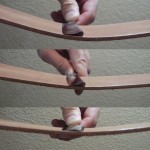
The pictures depict the most amount of deflection to the least amount of deflection commonly used. You should strive for the middle picture. The picture is a little skewed, but there isn’t as much deflection as it appears. The bottom is also acceptable and represents a full amount of tension coupled with downward pressure from the razor. As you can see, the downard pressure from the razor adds some deflection to the strop.
I apologize that my assistant wasn’t able to take the photos head on, but I hope you get a better idea of the amount of slack you can/should use.
Flipping the Razor
By far the hardest skill to learn is flipping the razor. This is what all strop and edge damage results from. Incorrect flipping of the razor will result in a nicked strop and possibly a rolled edge. Click on the image below to see how to properly flip your razor.
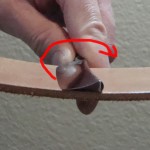
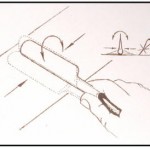
You flip the razor by rotating on the spine. The edge does all of the moving, the spine stays still. As an additional preventative measure, you should try to flip the razor while the razor is still moving. In other words, slow down the stroke, then while the razor’s edge is still moving very slowly, turn the razor 90° so that the edge is vertical, stop the razor, start moving it in the other direction, then lay the edge flat. Doing this will help prevent nicks and cuts to your strop.
The Laps or Strokes
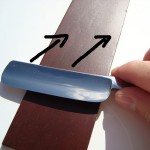
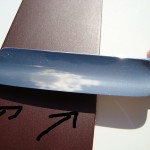
Stropping is a useless exercise if you don’t do enough laps or don’t do them properly. While it doesn’t matter whether you start stropping at the top of the strop or at the bottom of the strop, it is important to get into the habit of stropping in an X-pattern. Put in words, you start at the top of the strop with the edge facing towards the top, and the toe to the left (assuming you’re right handed). Then as you drag the razor down, or towards you, you pull the razor to the right (or from the heel to the toe). Repeat for the other direction.
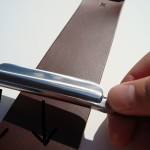
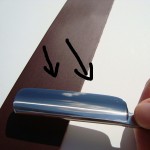
You can add some flourishes to the stroke as well. For instance, you can rotate the blade 45° so that the razor is at an angle such as this: / or \. Doing so involves some wrist action. I like to call this type of stroke the “Figure 8.”
Final Thoughts
Stropping is by far the most important straight razor maintenance skill you will learn. If you learn to do it properly, your razor will last for many months. Fail to strop properly and your razor won’t stay sharp for long. To get the most out of your stropping, follow these simple guidelines.
- Strop often – before & after a shave is ideal.
- There’s no such thing as too many laps – at least 100 is what I recommend.
- Utilize a cotton/linen strop – a canvas component is a stropping effect multiplier. Use the cotton before the leather and after the shave to dry the razor.
- Use an X-Stroke or Figure-8 Stroke – these strokes make sure you strop the entire edge of the razor.
- Wider is not better – if your using an x-stroke, a 3″ strop does you no good.

![]()
 The cordovan used in this strop is different than the cordovan you normally see in strops. It is a darker color, more similar to the cordovan found on shoes than on Japanese cordovan strops. It also performs differently. The leather starts off extremely creamy and supple. It then breaks in to something completely unique. If Japanese cordovan feels extremely slick and plastic-like, Horween cordovan feels life like and has an extremely nice draw to it.
The cordovan used in this strop is different than the cordovan you normally see in strops. It is a darker color, more similar to the cordovan found on shoes than on Japanese cordovan strops. It also performs differently. The leather starts off extremely creamy and supple. It then breaks in to something completely unique. If Japanese cordovan feels extremely slick and plastic-like, Horween cordovan feels life like and has an extremely nice draw to it.
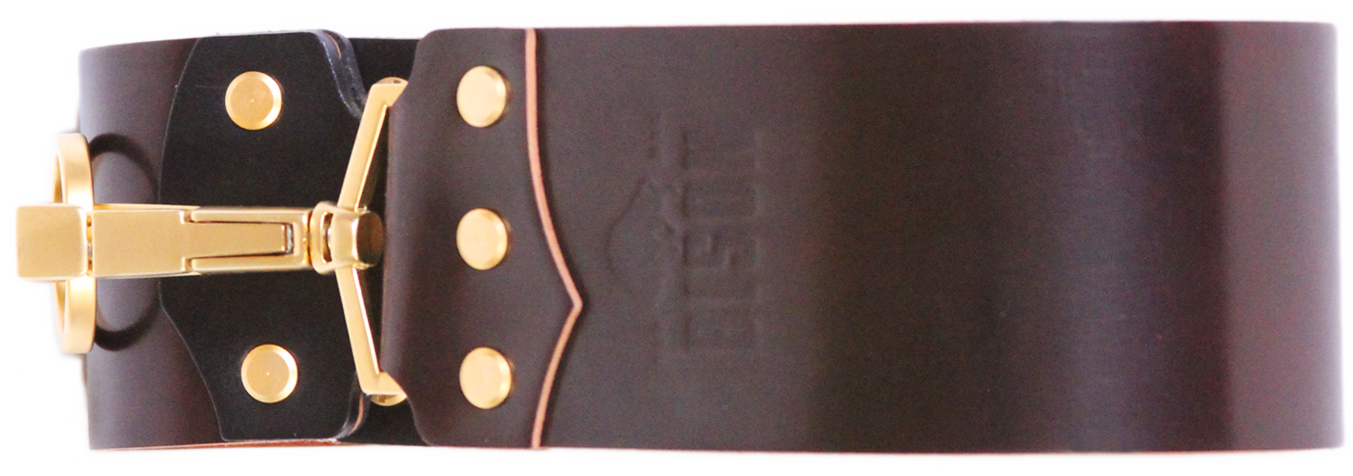
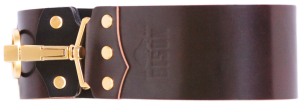















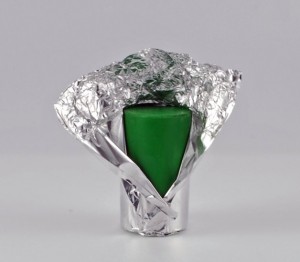
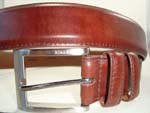 1. Leather Belt
1. Leather Belt
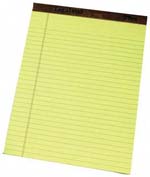 5. Back of a Legal Pad
5. Back of a Legal Pad



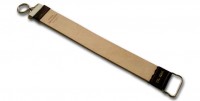
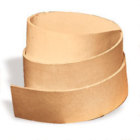 The point of stropping is to remove the oxidation on the edge and realign any burrs that may have formed. Removing the oxidation (rust) keeps the razor’s edge sharper, longer. Oxidation is the enemy of sharpness (honing accomplishes the same objective, but is much more costly and time consuming). Yet, you don’t need an actual strop to start your straight razor journey. An actual strop makes the process easier, looks better, and usually consists of quality components. However, in the end, a strop is just a piece of leather. Regardless of the leather quality, all it is is a piece of leather attached to a mounting point, with or without a handle at the other end.
The point of stropping is to remove the oxidation on the edge and realign any burrs that may have formed. Removing the oxidation (rust) keeps the razor’s edge sharper, longer. Oxidation is the enemy of sharpness (honing accomplishes the same objective, but is much more costly and time consuming). Yet, you don’t need an actual strop to start your straight razor journey. An actual strop makes the process easier, looks better, and usually consists of quality components. However, in the end, a strop is just a piece of leather. Regardless of the leather quality, all it is is a piece of leather attached to a mounting point, with or without a handle at the other end.